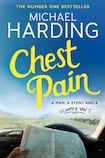
Michael Harding’s newest read will be familiar to his fans, delivering his usual humour and poetic language in the voice of the philosopher he has come to be known as for his commentary on spirituality, mental health and Irish life.
Chest Pain is perhaps though, more intimate than Harding’s previous books. Dedicated to his wife Cathy, the book is a reflection on love, and his propensity to retreat into solitude when feeling unwell, in this instance, keeping from his ‘beloved’ the signs of an illness that would eventually lead to a heart attack.
In his opening chapter The Rude Awakening, Harding wonders if he has “walked the walk,” and if, in his 65 years of life, he has managed to “open his heart fully to the world,” until the moment of his heart attack. Six months post his near-death experience, Harding is awaiting repairs on his new campervan, part of his promise to himself following recovery, to become more physically active through leisurely expeditions and walks along the coast. The heart, both physically and metaphorically, forms the core of the narrative. Harding interweaves his observations of a young couple planning a wedding in a hotel where he is having coffee, with the story of his coronary event. As a passive listener, Harding feels moved by the enthusiasm and joy of the engaged lovers, as they discuss the details of their big day with the hotel manager. He talks about how he wants to interrupt their chat to tell them: “Do you realise you are beginning the greatest adventure of your life?”
Over the course of the memoir, Harding is reflecting on his choice of secular life over the priesthood, which has delivered him many blessings in the form of a fulfilling marriage, and the experience of family life. He occupies his usual territory of the spiritual and majestic, discussing faith and love closely, asking questions about the right to be alone, and how to balance this with true openness in relationships.
Harding’s journey takes him to Warsaw, where he attempts to write a book, but in reality, spends his time visiting Orthodox Christian churches, and grows heavy under the strain of what he does not yet realise is a failing artery. The theme of confession comes in and out of the narrative, as he describes his reluctance to tell his partner of his growing list of symptoms: leg numbness, breathlessness and overwhelming fatigue. He turns to “Doctor Google” for explanations and seeks the familiar comfort of spirituality, retreating into the habitual solitude that has been a constant in his life.
As his condition worsens over the course of a year, he turns to prayer, icons, a quest to find snow in winter, a sense of mission in the abortion referendum, a book tour, and finally, his hospitalisation. Following his procedure, the campervan in the title becomes important as a symbol of new life. Describing the objects that have been transformative to him Harding writes: “The typewriter turned me into a writer. The chalice turned me into a priest”. In his post operation euphoria, he thinks of the campervan as the “gleaming chariot” that will take him out of danger, and back into a time of youth and bliss, travelling the roads of Donegal with his “beloved”.
Intimate insights of this key relationship are peppered through the book including their journey through Donegal on bicycles in 1987, their anniversary in a Galway hotel in the 90s, during which Harding gets locked out of their room, naked, and her gentle notes on his need to purchase a new pair of togs, so that he doesn’t make women in the sauna “exit like a swarm of demented bees”. The specialness of their bond, that seems to allow both to be artists, with freedom and space to explore their craft, forms the basis of a very solid and lasting marriage, which Harding pays tribute to in this memoir.
The unblocking of the artery also allows Harding to return to what he describes as “a new well” of material, having suffered from writer’s block in 2018. He emerges from the experience with a book to write (this title) and a newfound appreciation of his mortality, in which a joint solitude is central: “The beloved and I had found a new way of being alone. A solitude that both of us inhabited, a solitude that felt like a tent made by God, inside which we were safe.”
“Both the writer and the monk engage with solitude. But the writer always surfaces again, to tell the tale.”
Harding is both monk and writer, grateful for his gifts, and writing from the heart.












